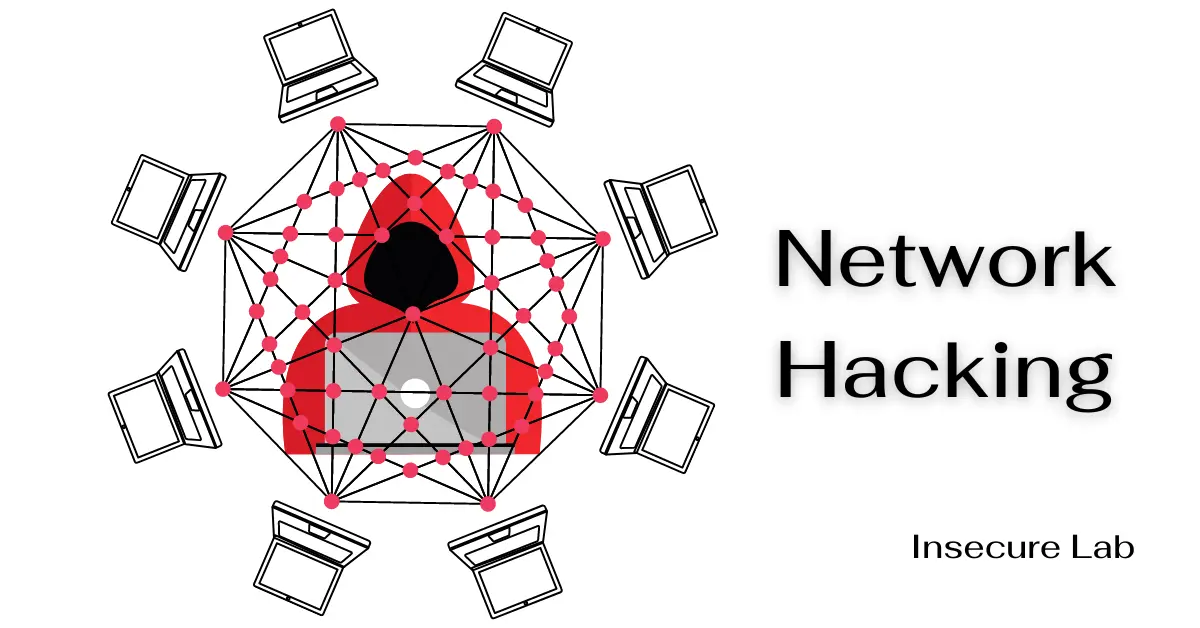🔍 Search
📥 Subscribe
Network Hacking

Table of Contents
This guide explains the concept of network hacking, the steps involved, types of attacks, and prevention techniques in the context of ethical hacking and cybersecurity.
What is Network Hacking?
Network hacking is the systematic process of probing, analyzing, and exploiting a network infrastructure in order to evaluate its security posture. Its main purpose is to secure the network by simulating real-world cyber attacks in a controlled environment.
Ethical hackers perform this process with explicit permission to uncover vulnerabilities, assess risks, and recommend remediation strategies. The organization then implements the necessary preventive measures before malicious actors can exploit them.
Steps in Network Hacking
Ethical network hacking follows a structured process, typically involving the following steps:
1. Reconnaissance

Network reconnaissance is the first stage where the ethical hacker collects as much information as possible about the target. This involves identifying IP addresses, active systems, domain names, and employee details using both passive methods (e.g., searching public databases, social media) and active methods (e.g., pinging, traceroute).
The goal is to understand the target's infrastructure, employees and potential vulnerabilities without alerting the target, thereby laying the groundwork for next steps. Techniques include tools such as Whois, Nslookup and Shodan, with passive methods avoiding direct contact to minimize detection.
This step is crucial for determining the attack surface, and research shows that if done thoroughly it can uncover up to 80% of exploitable information.
2. Scanning

Scanning involves using tools to probe the target for open ports, services, and vulnerabilities based on information gathered during reconnaissance. This includes port scanning to identify open TCP/UDP ports (e.g., using Nmap) and vulnerability scanning to detect known vulnerabilities in services (e.g., with Nessus).
Its purpose is to map the attack surface of the network, identifying potential entry points such as open ports running unpatched services. Scanning can be performed in various ways, such as SYN scans for stealth or UDP scans for less common ports, depending on the configuration of the target.
This step is automated with tools like OpenVAS, and it helps prioritize targets for further exploitation. Studies show that it can reduce the time to identify critical vulnerabilities by up to 50%.
3. Enumeration

Enumeration is the phase in which the hacker extracts detailed information from the target system, such as user accounts, network shares, services, and system configuration. Techniques include SNMP enumeration to query network devices, SMB enumeration to list shares, and LDAP queries to extract user data.
Its goal is to collect sensitive data or credentials that can be used to gain access, such as finding default passwords or misconfigured services. Tools such as Enum4linux and NetBIOS enumerators are commonly used, and this step is often followed by scanning to target specific systems.
This step is crucial for identifying exploitable information, and it can uncover hidden resources, with research indicating that it increases the success rate of subsequent exploitation by as much as 30%.
4. Vulnerability Assessment
In a vulnerability assessment, the hacker identifies and verifies specific vulnerabilities in the target system or service, such as out-of-date software, incorrect configurations, or weak authentication mechanisms. This can be done manually by checking for known vulnerabilities or by using automated tools such as Nessus or OpenVAS.
Its purpose is to confirm which vulnerabilities can be exploited, ensure testing is focused and effective, and prioritize based on severity. This step often involves comparing the findings with databases such as CVE (Common Vulnerabilities and Exposures) to assess risk.
It is a bridge between enumeration and exploitation, and studies show that it can reduce false positive results by up to 40%, making exploitation more targeted.
5. Exploitation

Exploitation involves gaining unauthorized access to a system or network by exploiting identified vulnerabilities, which mirrors how a real attacker might intrude. This can include exploits such as SQL injection, cross-site scripting (XSS), remote code execution, or buffer overflow, which are often triggered by restricted access.
Its goal is to gain initial access and then escalate privileges to the administrator level if possible using tools such as the Metasploit Framework or Core Impact. This phase tests the effectiveness of security controls, and may involve web application attacks, network device compromise, or client-side exploitation.
Research shows that the majority of breaches in real-world attacks occur at this level, highlighting its importance in ethical testing, where the success rate for known vulnerabilities is as high as 70%.
6. Post Exploitation
Post-exploitation occurs after gaining access, where the hacker escalates privileges, installs backdoors, and collects sensitive information, simulating persistent threats. This includes lateral movement within the network to access other systems, exfiltrate data, or install persistent access mechanisms such as rootkits.
It aims to test how well the organization can detect and respond to ongoing attacks, using tools such as Mimikatz for credential dumping, PowerUp for privilege escalation, and Empire for post-exploitation activities. It also includes simulating covering tracks such as deleting logs to test detection capabilities.
This step is crucial for understanding the depth of a potential compromise, and it can reveal unexpected details, such as how easily an attacker can move laterally, which are often overlooked in initial assessments.
7. Reporting
Reporting is the final step, where the hacker compiles a detailed report of all findings, including vulnerabilities discovered, exploits used, and recommendations for remediation. This report is provided to the organization to help them improve their security posture, ensuring actionable steps are taken.
It includes technical details, risk assessments, and prioritized recommendations, such as patching systems, improving firewalls, or training employees. This report is important for compliance and legal purposes, ensuring transparency and accountability in the testing process.
Although this is not part of the hacking process, it is essential to ethical hacking, and research shows that when implemented effectively it can reduce the risk of a future attack by up to 60%.
Types of Network Attacks
Network attacks can target different layers of the network stack, from the physical infrastructure to the application layer protocols. Below is a detailed list with examples of each attack to illustrate their impact:
1. DoS and DDoS Attacks
In denial of service (DoS) and distributed denial of service (DDoS) attacks, hackers take control of a system or network by sending excessive traffic to it, making it unavailable to legitimate users.
Example: Using a botnet to flood a website with requests, causing it to crash.
2. Man-in-the-Middle (MitM) Attacks
In MITM attacks, attackers often exploit insecure connections to intercept communications between two parties, steal data, or alter messages.
Example: Evil Twin attack (setting up a rogue Wi-Fi hotspot in a cafe to capture passwords and sensitive data of users connecting to it).
3. Network Sniffing
In network sniffing, attackers steal unencrypted data, such as passwords or sensitive information, by capturing network traffic, often over unsecured networks.
Example: Using a tool like Wireshark to capture unencrypted passwords sent over public Wi-Fi networks.
4. Malware Attacks
In malware attacks, hackers use malicious software such as viruses, worms, Trojans, ransomware, and spyware to infect systems, steal data, or disrupt operations.
Example: The WannaCry ransomware encrypts files and demands payment for decryption, as seen in the 2017 global attack.
5. Zero-Day Exploits
In a zero-day exploit, attackers target vulnerabilities unknown to the software vendor, giving them the opportunity to exploit a system, often silently, before a patch is available.
Example: Exploiting a newly discovered vulnerability in a web browser to install spyware before a fix is released, as seen in targeted attacks.
Defense Techniques
To defend against network attacks, organizations can implement a variety of defense strategies, which are detailed below:
1. Firewalls
Firewalls monitor and control incoming and outgoing network traffic based on predefined security rules, acting as a barrier. They prevent unauthorized access and filter malicious traffic, keeping the internal network safe from external threats.2. Intrusion Detection and Prevention Systems (IDPS)
IDPS monitor network traffic for suspicious activity, such as unusual communication patterns, and can alert or block threats. They also detect and respond to potential intrusions in real time, enhancing network security by identifying botnet traffic or malware attacks.3. Regular Updates and Patching
Regularly updating software and systems fixes known vulnerabilities, such as flaws in out-of-date software, allowing security patches to be applied immediately. This practice prevents exploitation by attackers, reduces the attack surface, and is a fundamental layer of defense.4. Strong Authentication
Implementing strong authentication methods like multi-factor authentication (MFA) requires multiple forms of verification, such as passwords and biometrics. MFA adds multiple layers of security, making it harder for attackers to gain access and is critical to protecting user accounts.5. Network Segmentation
Dividing the network into smaller, isolated segments can limit the spread of attacks by restricting access between the segments. By isolating critical systems, network segmentation reduces the impact of a breach, prevents damage and enhances security.6. Encryption
Encrypting data in transit, such as HTTPS, and at rest, such as stored files, keeps it secure from unauthorized access. Encryption ensures that even if data is intercepted, it remains unreadable without the proper decryption key, keeping sensitive information secure.7. Training and Awareness
Training employees on security best practices, such as recognizing phishing emails, reduces human error, which is a common attack. Educated employees are less likely to fall for social engineering tricks, increasing overall network security.8. Security Audits and Penetration Testing
Vulnerabilities are identified by performing regular security audits and penetration testing that simulate real-world attacks. These tests detect and fix vulnerabilities before malicious actors can exploit them, ensuring proactive defense.9. Backups and Disaster Recovery
Maintaining regular backups and having a disaster recovery plan ensures business continuity in case of attacks. In the event of data loss, backups allow for restoration, minimizing downtime and financial impact.10. Incident Response Plan
Having a predefined incident response plan helps to quickly mitigate security incidents by outlining detection, response, and recovery steps. This plan ensures to efficiently deal with breaches, minimizing damages and improving recovery time.Summary
Network hacking is a complex and multifaceted field within cyber security. Understanding its fundamentals, types of attacks, the steps involved, and prevention strategies is crucial for individuals and organizations to protect their networks and sensitive data.
While malicious hacking poses significant threats to individuals and organizations, ethical hacking plays a vital role in identifying and mitigating vulnerabilities within computer networks.
